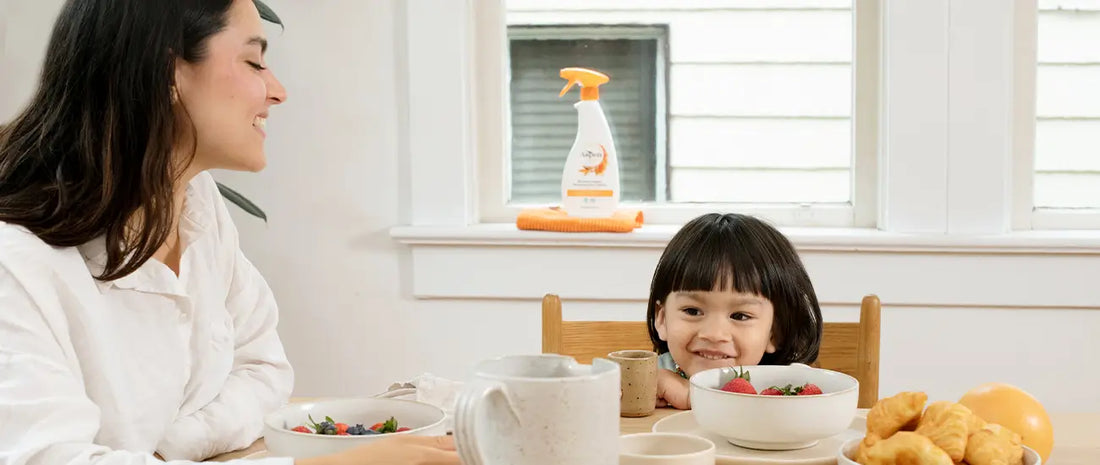
Guide To Cleaning Products and Indoor Air Quality
Whether you love cleaning or see it as a necessary chore, rest assured that keeping your home clean and sanitized is more crucial than ever. Your regular cleaning efforts protect your family’s health and help maintain your home’s longevity. Many households use specialized cleaning products to tackle dirt, germs, and grease. However, these same products might be doing more harm than good.
It's important to be aware that many conventional cleaning products contain toxic chemicals that can harm your health and lower indoor air quality. This knowledge can be a powerful motivator to switch to natural cleaning supplies, creating a safer, healthier home environment while reducing environmental impact.
The hidden danger lies in the ingredients of many cleaning products, which often include irritants that affect your skin, eyes, and throat. Exposure can lead to headaches, sinus issues, and even more severe health risks. For instance, mixing chlorine bleach with acid produces a toxic gas that can be lethal. Choosing natural cleaning products eliminates these risks, helping you clean effectively and safely.
Harmful Effects of Cleaning Products on Indoor Air Quality and Health
Your home may look spotless, but your cleaning products could harm your health by contaminating the air. Indoor air quality often goes overlooked, yet it’s crucial for your well-being—especially for children, who are more vulnerable to poor air conditions.
One major concern is volatile organic compounds (VOCs), chemicals found in cleaning products, paints, pesticides, and even furniture. These compounds are released into the air during use and can continue to emit harmful fumes while in storage.
VOCs and Health Risks
VOCs are typically more concentrated indoors, where they can cause respiratory problems, headaches, dry eyes, nasal congestion, nausea, and fatigue. Long-term exposure to higher concentrations has even been linked to cancer. While some VOCs occur naturally, many come from the products you use daily to clean your home.
Other Indoor Pollutants to Watch Out For
Indoor air pollution doesn’t stop at VOCs. Common culprits include:
- Cigarette smoke
- Disinfecting products
- Pesticides
- Gas stove and fireplace emissions
- Pet dander
- Mold
- Asbestos
- Lead
- Radon
With pollutants everywhere, cleaning is vital for maintaining a healthy home. But selecting the right cleaning products is key. By choosing natural, non-toxic cleaning solutions, you can reduce exposure to harmful chemicals and create a safer living space for your family.

What Cleaning Products Are Dangerous?
The danger lies in the ingredients. Many conventional cleaning products contain harmful chemicals, especially volatile organic compounds (VOCs). These are commonly found in:
- Aerosol sprays
- Air fresheners
- Chlorine bleach (consider oxygen bleach powder instead)
- Dish detergents
- Rug and upholstery cleaners
- Furniture and floor polish
- Oven cleaners
A simple way to evaluate cleaning products is by checking the label. Look for terms like low VOC or no VOC, and avoid products with fragrances, flammable ingredients, or known irritants.
Should You Go Green?
Opting for green or natural cleaning products is a step in the right direction since many avoid flammable ingredients and artificial fragrances. However, not all natural products that are completely safe - some may still contain harmful chemicals.
To ensure safety, check the product's website for certifications and compliance with industry standards. At AspenClean, we prioritize rigorous certification processes to offer safe, eco-friendly cleaning solutions you can trust.
Chemical-Free Cleaning Products for Better Indoor Air Quality
Ensuring healthy indoor air starts with choosing the right cleaning products, but there are other steps you can take to minimize air pollution in your home:
- Use cleaning products sparingly—less is more.
- Never mix cleaning products, especially those containing chlorine bleach.
- Always read and follow label instructions.
- Improve ventilation by opening windows or using fans while cleaning.
- Rinse surfaces thoroughly after cleaning.
- Dispose of old, partially used cleaning products.
- Avoid or limit products with pine or citrus oils, which can release harmful compounds.
Making your own cleaning solutions can help you avoid harmful chemicals and improve air quality. However, not all homemade solutions are inherently safe. For example, while chlorine bleach is a powerful cleaner, it’s also highly toxic and dangerous when mixed with acids.
Safe Homemade Cleaning Recipes
For those looking to clean safely and effectively, here are a few simple and non-toxic recipes you can create at home.

People have created homemade cleaning solutions for generations that deliver remarkable results without harming indoor air quality. You can tackle grime and germs effectively while keeping your home safe with just a few simple ingredients.
DIY Heavy-Duty Scrub
Perfect for bathrooms and other grimy spaces:
- ½ cup baking soda
- ¼ cup white vinegar
DIY Counter Cleaner
Countertops require extra care due to their varied materials:
- For non-sensitive surfaces: Mix equal parts water and vinegar, then spritz.
- For sensitive surfaces or an alternative to vinegar: Use equal parts water and rubbing alcohol or vodka.
This simple solution is completely non-toxic:
- Cut a lemon in half, rub it on the surface, let it air dry, and rinse with water.
This universal cleaner is great for floors, bathrooms, and more - just avoid granite and marble due to its acidic content:
- ¾ cup vinegar
- ¼ cup lemon juice
- A few drops of dish soap
Why Choose AspenClean?
If DIY isn’t your style, AspenClean offers organic cleaning products made from the highest-quality ingredients to provide safe and effective results. We’ve done the research to meet the strictest standards, so you don’t have to compromise on safety or performance.
Discover More
Visit the AspenClean blog for tips on natural cleaning, safe product recommendations, and even booking professional cleaning services. Get weekly updates to make eco-friendly living effortless.